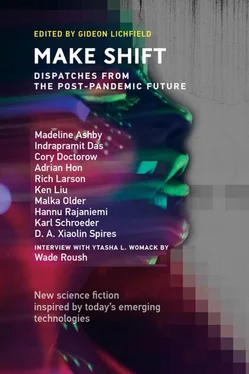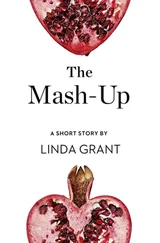“Yeah, and why can’t we? I keep hearing explanations, but they never add up. My cousin swears it’s totally to control the electorate.”
“No, it’s the opposite.” Remy remembers the fine-tuning that went into the system. In the quadratic system your first vote is free, but you can buy more. Each vote after the first one costs the square of its number times 10. So the second one costs $40, the third costs $90, the fourth $160, and if you want to buy a thousand you’ll be paying $10 million. The system’s designed so that people literally invest in the issues that matter the most to them. People with a lot of money might sway the vote, but only by putting a lot of cash into the public purse.
Early on some developers had tried paying off large swathes of the city’s poorest to vote their way. The random lottery solves that problem, by making sure that most, possibly all of your vote-fixing money goes to people who won’t end up being able to vote. Instead, a representative minority casts the actual ballots.
“Yeah, it probably feels wrong to people who are used to the old system. But a random lottery to select voters makes it way more expensive to buy votes. People just don’t get the math.”
“What?” says Sendak. “You think that somebody who doesn’t get the math went after Cawley, thinking he could do something he couldn’t to the voting system? What a waste.”
Remy blinks. “Or maybe Cawley just had gambling debts. We’ll see.”
BUT IT WASN’T GAMBLING DEBTS. “THE BANK SAYS CAWLEY WAS GETTING SOMEpretty big payouts from offshore accounts,” Kraft tells Remy an hour later. “He wasn’t losing money, he was making it. Tons of it.”
Remy’s taking the call outside the Cawley house, which is in one of the reconstructed neighborhoods near Downtown. This side street has been given over to bikeways and parkland, probably after the Second Wave. Many of the eyesore buildings and empty lots in the area, fought over for decades by developers, are now green space. After the contraction of the fossil fuel industries, the air is clean.
Sendak strolls up. After a cursory look through the house, which has already been thoroughly combed by her team, she’s decided to speak to the neighbors. Community Outreach, like Remy suggested. She’s wearing a mask, which she carefully stows as she comes up the walk. “Lot of locals still won’t talk to you at the door unless you’re wearing one,” she explains.
“That’s ridiculous. There hasn’t been a case in the city in months.”
“Once bitten, twice shy. Thrice bitten, thoroughly paranoid. Find anything?”
He shakes his head. “I’m sure your people saw that their suitcases are still here. Just to follow up, I compared the trash to what they had in the pantry. When people are getting ready to travel—or run—they tend to use up their perishables. That’s not the case here. I don’t think they left of their own accord.”
She waits, then when he just stands there, she says, “This is the part where you say, ‘What about you, Maureen? Did you find anything?’ And where I say, ‘Yes, why yes, I did.’”
Agreeably, he says, “What about you, Maureen? Did you find anything?”
She takes out her phone. “A couple of people saw a black SUV parked in front of the Cawley place two days ago. It wasn’t there long.”
“Did they get a license plate? Because there must be thousands of black SUVs in town.”
“A lot of people ’round here have porch cams. So I asked around, just to see if anybody had footage that showed the street. Got a couple of hits.”
She shows him the videos on her phone. There are three, none of which are good enough to read the license plate. One, though, shows a vague, pixelated profile of the driver through the side window.
“That might be a tattoo on his neck,” says Remy, “but it’s too dark to see the face. Maybe they can do signal processing on it. Wait, what’s that?” He points.
“Hmm—wrist watch?”
“Mm, more like a tracker.” After the first vaccines proved to be insufficient on their own, social isolation and contact tracing were rolled out nationwide. Companies making fitness trackers were happy to add the functionality to their devices, and suddenly they were no longer just for exercise buffs and ‘quantified self’ people. At one point he remembers every single person he met wearing a tracker of some kind—mostly on the wrist.
“So we got nothing,” she admits. He stares out at the little urban gardens for a minute, and when he glances at Sendak he sees a pinched expression on her face. That must be what frustration looks like.
“Look, Remy, I’m on the clock,” she says. “I’ve gotta get back to the lab, is there anything more you can do?”
Remy literally has no idea. He doesn’t like this feeling of helplessness. “I live a few minutes from here. Could you drop me off before you go back?”
She sighs. “Okay. Maybe Kraft’s got a new plan.”
They drive into one of the former business areas, now converted into low-cost housing like much of Downtown. Sendak parks next to a glass-walled building that used to be part of an office park. It’s across from a real park, with trees and grass and open space. This is Remy’s essential source of peace and quiet if he’s outside, but today it’s overrun with people. Somebody’s holding a political rally.
He starts to tune it out as he gets out of the car, then notices something. “There’s a friend of mine,” he says to Sendak.
She blinks. “How can you tell?” The nearest person is a hundred feet away.
“He’s got a flag up in my glasses.” Remy crosses the road and heads for the gates to the park. This is only possible because he tunes the detail levels right down to the minimum; even so he can feel the chaotic pressure of the crowd in his mind as he approaches it.
He expected Sendak would drive away but she gets out of the car and follows him up to a table by the entrance. Here, volunteers are handing out wrist bands. One jumps up, laughing, as Remy approaches. “Remy Reardon! How you doing, man? And who’s your friend?” Remy belatedly remembers to introduce Sendak.
“Xander Reese, nice to meet you. So you know the great Remy Reardon.”
“Yeah, we work together, sometimes. How do you know him?”
“I was the contact tracing expert at St. Mary’s Hospital.” There’s just the faintest pause then, as he and Sendak exchange a look; St. Mary’s is a psychiatric hospital. This shared look is one of those episodes of invisible communication that intensely frustrate Remy. When it happens, it’s like the other people are talking behind an invisible pane of glass. “I also programmed his glasses,” Xander finishes.
Sendak crosses her arms and stares into the crowded park. “Look at it! A mob. Who’d have thought ordinary folk would get that close again?”
“That’s why we’re here.” Reese holds up one of the wrist bands. “Some people have been tossing their trackers. Privacy, you know? I get it. But if there’s an outbreak, we need to trace each and every contact to squash it. So you gotta wear one to get in.”
The sound of the crowd is creeping around the edges of Remy’s mind, increasingly distracting. He stands still, head tilted, vaguely aware that Reese is telling Sendak about the contact tracing app, about the cryptography it uses to perfectly preserve anonymity.
“Crypto!” Her voice rises in a way that means Remy should pay attention. “Like these clowns and their quadratic vote! It’s all game theory and math. You can’t turn something as sloppy as human nature into math.”
Reese shrugs. “I guess you’re in favor of citizens’ panels?”
“Damn straight. Grab a bunch of people at random, just like you do for jury trials. Give ’em a minimal test to make sure they understand the issue they’re gonna be dealing with, and then let ’em work the problem. But no, ‘the quadratic way is the best!’ Bend over backward to prevent voter fraud by draining away all the human elements, until all that’s left is an algorithm. It solves your problem, but only by sucking the life out of politics.” She takes a calming breath. “Okay,” she says, “so here’s a question: What could you do if you could hack ballot software?”
Читать дальше












